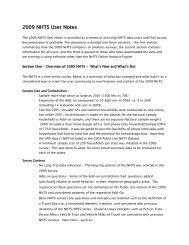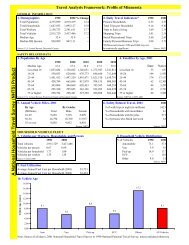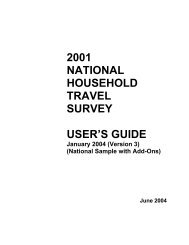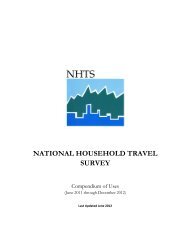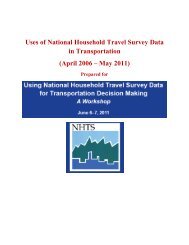- Page 1 and 2: ORNL/TM-2001/248U.S. DEPARTMENT OF
- Page 3 and 4: TABLE OF CONTENTSCHAPTER 1INTRODUCT
- Page 5 and 6: APPENDICESAppendix A Travel Concept
- Page 7 and 8: CHAPTER 1INTRODUCTION1INTRODUCTIONN
- Page 9 and 10: LIST OF FIGURESDISTINCTION BETWEEN
- Page 11 and 12: CHAPTER 1INTRODUCTIONPOLICYMAKERS r
- Page 13 and 14: As in the previous surveys, in the
- Page 15 and 16: public’s opinion of transportatio
- Page 17: there is no way of knowing which tr
- Page 21 and 22: • Chapter 8 presents data on the
- Page 23 and 24: CHAPTER 2ESTIMATES OF TOTAL TRAVEL2
- Page 25 and 26: LIST OF TABLESTABLE 2.1 TRAVEL SUMM
- Page 27 and 28: CHAPTER 2ESTIMATES OF TOTAL TRAVELE
- Page 29 and 30: was acquired. Thus, an annual estim
- Page 31 and 32: Table 2.1 provides summary statisti
- Page 33 and 34: TABLE 2.2TOTAL PERSON MILES OF TRAV
- Page 35 and 36: The distribution of travel by data
- Page 37 and 38: Nearly 80% of all travel was report
- Page 39 and 40: TABLE 2.6TOTAL PERSON MILES OF TRAV
- Page 41 and 42: TABLE 2.7TOTAL VEHICLE MILES OF TRA
- Page 43 and 44: In 1995, most household transportat
- Page 45 and 46: CHAPTER 1IntroductionCHAPTER 2Total
- Page 47 and 48: CHAPTER 3DETERMINANTS OF TRAVEL3DET
- Page 49 and 50: 1995 VEHICLES BY VEHICLE TYPE(THOUS
- Page 51 and 52: LIST OF TABLESTABLE 3.1TABLE 3.2TAB
- Page 53 and 54: CHAPTER 3.DETERMINANTS OF TRAVELTRA
- Page 55 and 56: Dramatic changes in demographics an
- Page 57 and 58: FIGURE 3.1CHANGES IN SUMMARY DEMOGR
- Page 59 and 60: Table 3.2 shows that the population
- Page 61 and 62: FIGURE 3.4DISTRIBUTION OF DRIVER’
- Page 63 and 64: The percentage of both males and fe
- Page 65 and 66: Between 1969 and 1995, the average
- Page 67 and 68: Employment status influences the av
- Page 69 and 70:
TABLE 3.8NUMBER OF HOUSEHOLDS BY HO
- Page 71 and 72:
TABLE 3.9DISTRIBUTION OF HOUSEHOLDS
- Page 73 and 74:
The number of vehicles per househol
- Page 75 and 76:
FIGURE 3.10DISTRIBUTION OF HOUSEHOL
- Page 77 and 78:
Figure 3.11 shows the share of hous
- Page 79 and 80:
In 1995, the average mileage driven
- Page 81 and 82:
CHAPTER 1IntroductionCHAPTER 2Total
- Page 83 and 84:
CHAPTER 4PERSON TRIPS AND PERSON MI
- Page 85 and 86:
1995 PERSON TRIPS AND PERSON MILES
- Page 87 and 88:
TABLE 4.21TABLE 4.22TABLE 4.23TABLE
- Page 89 and 90:
CHAPTER 4PERSON TRIPS AND PERSON MI
- Page 91 and 92:
According to Public Transit in Amer
- Page 93 and 94:
FIGURE 4.1SUMMARY OF NATIONAL TRAVE
- Page 95 and 96:
Both males and females increased th
- Page 97 and 98:
The number of average daily person
- Page 99 and 100:
FIGURE 4.3AVERAGE DAILY PERSON TRIP
- Page 101 and 102:
FIGURE 4.4AVERAGE PERSON TRIP LENGT
- Page 103 and 104:
TABLE 4.7NUMBER OF PERSON TRIPS BY
- Page 105 and 106:
TABLE 4.8AVERAGE DAILY PERSON TRAVE
- Page 107 and 108:
TABLE 4.9NUMBER OF PERSON TRIPS TAK
- Page 109 and 110:
TABLE 4.11NUMBER OF PERSON TRIPS TA
- Page 111 and 112:
FIGURE 4.6PERCENTAGE OF PERSON TRIP
- Page 113 and 114:
TABLE 4.14AVERAGE DAILY PERSON TRIP
- Page 115 and 116:
In 1995, most households were compr
- Page 117 and 118:
Figure 4.9 and Table 4.16 illustrat
- Page 119 and 120:
TABLE 4.17NUMBER OF PERSON TRIPS BY
- Page 121 and 122:
TABLE 4.18AVERAGE TRIP LENGTH BY 19
- Page 123 and 124:
TABLE 4.20AVERAGE PERSON TRIP LENGT
- Page 125 and 126:
TABLE 4.21STATISTICS ON SEGMENTED P
- Page 127 and 128:
FIGURE 4.10STATISTICS ON SEGMENTED
- Page 129 and 130:
TABLE 4.23STATISTICS ON DAILY PERSO
- Page 131 and 132:
FIGURE 4.11STATISTICS ON DAILY PERS
- Page 133 and 134:
FIGURE 4.12DISTRIBUTION OF PERSON T
- Page 135 and 136:
TABLE 4.26NUMBER OF PERSON TRIPS BY
- Page 137 and 138:
TABLE 4.28NUMBER OF PERSON MILES OF
- Page 139 and 140:
TABLE 4.30NUMBER OF PERSON TRIPS BY
- Page 141 and 142:
Tables 4.31-4.34 provide day-of-wee
- Page 143 and 144:
FIGURE 4.14DISTRIBUTION OF PERSON T
- Page 145 and 146:
TABLE 4.33NUMBER OF PERSON TRIPS BY
- Page 147 and 148:
TABLE 4.35NUMBER OF WEEKEND PERSON
- Page 149 and 150:
Chapter 5Vehicle Trips and Vehicle
- Page 151 and 152:
List of TablesTABLE 5.1 STATISTICS
- Page 153 and 154:
CHAPTER 5VEHICLE TRIPS AND VEHICLE
- Page 155 and 156:
5.3 TRIP CHARACTERISTICSHousehold v
- Page 157 and 158:
TABLE 5.1STATISTICS ON VEHICLE TRAV
- Page 159 and 160:
TABLE 5.2NUMBER OF VEHICLE TRIPS BY
- Page 161 and 162:
FIGURE 5.2DISTRIBUTION OF VEHICLE T
- Page 163 and 164:
TABLE 5.4NUMBER OF VEHICLE MILES OF
- Page 165 and 166:
Tables 5.6 and 5.7 show the length
- Page 167 and 168:
TABLE 5.7AVERAGE TIME (MINUTES) SPE
- Page 169 and 170:
Individuals 65 years of age and ove
- Page 171 and 172:
TABLE 5.10ANNUAL VEHICLE MILES OF T
- Page 173 and 174:
FIGURE 5.5ANNUAL VEHICLE MILES OF T
- Page 175 and 176:
NATIONAL PERSONAL TRANSPORTATION SU
- Page 177 and 178:
FIGURE 5.6ANNUAL VEHICLE TRIPS PER
- Page 179 and 180:
NATIONAL PERSONAL TRANSPORTATION SU
- Page 181 and 182:
As shown in Table 5.17, the greates
- Page 183 and 184:
FIGURE 5.8AVERAGE VEHICLE TRIP LENG
- Page 185 and 186:
TABLE 5.19NUMBER OF VEHICLE TRIPS A
- Page 187 and 188:
TABLE 5.21NUMBER OF WEEKEND VEHICLE
- Page 189 and 190:
On any day of the week, individuals
- Page 191 and 192:
Most trips were taken between 9 a.m
- Page 193 and 194:
CHAPTER 6JOURNEY TO WORK AND WORK-R
- Page 195 and 196:
1995 JOURNEY TO WORK PERSON TRIPS A
- Page 197 and 198:
LIST OF TABLESSUMMARY STATISTICS ON
- Page 199 and 200:
CHAPTER 6JOURNEY TO WORK AND WORK-R
- Page 201 and 202:
made as the driver of an automobile
- Page 203 and 204:
FIGURE 6.2SUMMARY STATISTICS ON JOU
- Page 205 and 206:
FIGURE 6.3DISTRIBUTION OF WORKERS B
- Page 207 and 208:
Between 1990 and 1995, the number o
- Page 209 and 210:
Traffic congestion is typically a m
- Page 211 and 212:
FIGURE 6.5NUMBER OF COMMUTE TRIPS P
- Page 213 and 214:
Workers designated as living in a S
- Page 215 and 216:
TABLE 6.9STATISTICS ON JOURNEY TO W
- Page 217 and 218:
The automobile was used for over 60
- Page 219 and 220:
FIGURE 6.7DISTRIBUTION OF JOURNEY T
- Page 221 and 222:
TABLE 6.12STATISTICS ON WORK-RELATE
- Page 223 and 224:
TABLE 6.13JOURNEY TO WORK PERSON TR
- Page 225 and 226:
TABLE 6.14DISTRIBUTION OF JOURNEY T
- Page 227 and 228:
TABLE 6.16NUMBER OF SEGMENTED JOURN
- Page 229 and 230:
TABLE 6.18NUMBER OF PERSON TRIPS (M
- Page 231 and 232:
CHAPTER 1IntroductionCHAPTER 2Total
- Page 233 and 234:
CHAPTER 7VEHICLE OCCUPANCY AND RIDE
- Page 235 and 236:
1995 VEHICLE TRIPS BY VEHICLE TYPE
- Page 237 and 238:
LIST OF TABLESTABLE 7.1 AVERAGE VEH
- Page 239 and 240:
CHAPTER 7VEHICLE OCCUPANCY AND RIDE
- Page 241 and 242:
Between 1977 and 1995, the average
- Page 243 and 244:
FIGURE 7.1AVERAGE VEHICLE OCCUPANCY
- Page 245 and 246:
As shown in Table 7.3, excluding th
- Page 247 and 248:
Household characteristics affect ve
- Page 249 and 250:
As shown in Table 7.5, households w
- Page 251 and 252:
Table 7.6 shows that the highest av
- Page 253 and 254:
As noted in Table 7.1, the lowest i
- Page 255 and 256:
On the average, commute vehicle occ
- Page 257 and 258:
CHAPTER 8TRAVEL BEHAVIOR OF POPULAT
- Page 259 and 260:
LIST OF TABLESTABLE 8.1 PERSON TRAV
- Page 261 and 262:
CHAPTER 8TRAVEL BEHAVIOR OF POPULAT
- Page 263 and 264:
As the baby boom generation approac
- Page 265 and 266:
FIGURE 8.1A COMPARISON OF PERSONAL
- Page 267 and 268:
FIGURE 8.2COMPARISON OF PERSON MILE
- Page 269 and 270:
The elderly generally either took s
- Page 271 and 272:
Tables 8.6-8.8 and Figures 8.3-8.6
- Page 273 and 274:
In 1995, employed women averaged ta
- Page 275 and 276:
FIGURE 8.5AVERAGE DAILY PERSON TRIP
- Page 277 and 278:
TABLE 8.9PERSON TRAVEL STATISTICS F
- Page 279 and 280:
FIGURE 8.7DISTRIBUTION OF AVERAGE A
- Page 281 and 282:
TABLE 8.12AVERAGE ANNUAL PERSON TRI
- Page 283 and 284:
TABLE 8.14AVERAGE DAILY PERSON TRIP
- Page 285 and 286:
TABLE 8.16PMT PER PERSON FOR PUBLIC
- Page 287 and 288:
APPENDIX ATRAVEL CONCEPTS AND GLOSS
- Page 289 and 290:
APPENDIX A.TRAVEL CONCEPTS AND GLOS
- Page 291 and 292:
GLOSSARY OF TERMSThis glossary prov
- Page 293 and 294:
Van A privately owned and/or operat
- Page 295 and 296:
50,000. In addition, contiguous cou
- Page 297 and 298:
SCHOOL OR CHURCHSchool/Church This
- Page 299 and 300:
WeekendWorkerWeekend is defined as
- Page 301 and 302:
Appendix BChanges in the 1995 NPTS
- Page 303 and 304:
APPENDIX B.CHANGES IN THE 1995 NPTS
- Page 305 and 306:
APPENDIX CWEIGHT CALCULATIONSCWEIGH
- Page 307 and 308:
APPENDIX C. WEIGHT CALCULATIONS 1WE
- Page 309 and 310:
APPENDIX DSTANDARD ERROR TABLESDSTA
- Page 311 and 312:
APPENDIX DSTANDARD ERROR TABLESTHE
- Page 313 and 314:
TABLE 4.5AVERAGE PMT PER PERSON BY
- Page 315 and 316:
TABLE 4.13AVERAGE DAILY PERSON TRIP
- Page 317 and 318:
TABLE 5.10Annual Vehicle Miles of T
- Page 319 and 320:
TABLE 5.14ANNUAL VEHICLE MILES OF T
- Page 321 and 322:
TABLE 7.4NUMBER OF VEHICLE TRIPS BY
- Page 323 and 324:
TABLE 8.8DAILY PMT PER PERSON FOR W
- Page 325 and 326:
TABLE 8.14AVERAGE DAILY PERSON TRIP
- Page 327 and 328:
Appendix EADJUSTMENT OF 1990 TRAVEL
- Page 329 and 330:
APPENDIX E.ADJUSTMENT OF 1990 TRAVE
- Page 331 and 332:
TABLE E.1ANNUAL PERSON TRIPS PER PE
- Page 333 and 334:
TABLE E.2ESTIMATED TRAVEL CHANGES F
- Page 335 and 336:
TABLE E.4TABLE 4. 1990 TRAVEL DATA
- Page 337 and 338:
APPENDIX FDIFFERENCES IN WORKERS AN
- Page 339 and 340:
Appendix F.Differences in Workers a
- Page 341 and 342:
TABLE F.2NUMBER OF WORKERS (IN 000)
- Page 343 and 344:
indicating that part of the differe
- Page 345 and 346:
TABLE F.4PERCENT OF NON-WORKERS COM
- Page 347 and 348:
APPENDIX GDIFFERENCES IN METROPOLIT
- Page 349 and 350:
APPENDIX G.DIFFERENCES IN METROPOLI
- Page 351 and 352:
APPENDIX HSEGMENTED TRIPS IN NPTSHS
- Page 353 and 354:
APPENDIX H.SEGMENTED TRIPS IN NPTSW
- Page 355 and 356:
APPENDIX IREVISED AVERAGE ANNUAL MI
- Page 357 and 358:
APPENDIX I.REVISED AVERAGE ANNUAL M
- Page 359 and 360:
APPENDIX JPROCEDURE TO ADJUST 1983
- Page 361 and 362:
APPENDIX JESTIMATES OF TOTAL TRAVEL
- Page 363 and 364:
TABLE J.2NUMBER OF HOUSEHOLDS AND T
- Page 365 and 366:
FIGURE J.1FITTED POLYNOMIAL CURVE A
- Page 367 and 368:
TABLE J.3REVISED 1990 INCOME CATEGO



